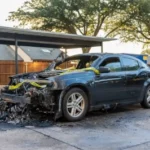Understanding Your Texas Crash Report (CR-3): Key Information Explained
The Texas Peace Officer’s Crash Report, commonly known as a CR-3 report, is the official record detailing a motor vehicle accident investigated by Texas law enforcement — Both in San Antonio and in the Rio Grande Valley region. This vital document serves as crucial evidence for insurance claims, personal injury cases, and legal proceedings. Understanding the information contained within your Texas accident report is essential for anyone involved in a crash.
Here’s a breakdown of the key elements you’ll typically find on a Texas crash report:
1. Basic Texas Crash Information
- Date, time, and exact location of the crash: This includes the street name, city, county, and potentially highway markers or cross streets if the accident occurred at an intersection.
- Weather and road conditions: The report will note conditions like rain, fog, slick roads, or the presence of construction zones.
- Collision type: Details like whether the crash was a hit-and-run, involved a school bus, or was a fatal accident.
2. Vehicle & Driver Details on a Texas CR-3 Report
- Details about each vehicle involved: The CR-3 report will list the license plate number, Vehicle Identification Number (VIN), make, model, year, and body style for every vehicle in the accident.
- Driver information: For each driver, you’ll find their name, address, contact details, driver’s license number, and insurance information.
- Passenger information: If there were passengers, the report may list their names, seating positions, and indicate whether safety restraints were used or if they were ejected from the vehicle.
- Drug and alcohol involvement: The report will indicate if the driver was required to take a test to detect alcohol or drugs in their system and the results if applicable.
- This information is very helpful to determine if there is potential for a DRAM Shop case when you were hit by a drunk driver where you look at potentially suing a bar, restaurant, bartender, or other establishment that serves alcoholic beverages to an “obviously intoxicated” individual. (see https://statutes.capitol.texas.gov/docs/al/htm/al.2.htm)
3. Crash Damage Assessment
- Damage description for each vehicle: This often includes a numerical code (XX-ABC-Y) indicating the direction of the force, the damage description, and the severity.
- Damage to property other than vehicles: The report will also document damage to objects like guardrails or utility poles.
4. Contributing Factors to the Texas Accident
- Officer’s opinion on contributing factors: The investigating officer will indicate the factors they believe contributed to the accident. This could include things like speeding, distracted driving, failure to yield, or unsafe lane changes.
- Vehicle defects or environmental/roadway conditions: These may also be noted if they played a role in the accident.
5. Officer’s Narrative & Accident Diagram
- Narrative description: The investigating officer provides a written summary of how they believe the accident occurred. This may include details about the sequence of events, driving conditions, and driver actions.
- Diagram: A visual representation of the accident scene, often showing the positions of the vehicles, directions of travel, and other relevant details.
6. Citations and Charges Issued in a Texas Crash Report
- Citations issued: Any traffic citations given to drivers involved in the accident will be documented.
Important Reminders for Interpreting Your Texas Crash Report
- Codes and Abbreviations: Texas crash reports use codes and abbreviations that can be confusing to interpret. If you have trouble understanding the report, consult an attorney or refer to online resources that explain the codes.
- Accuracy is Key: Review the report carefully for any inaccuracies or omissions. If you find errors, you should contact the investigating officer to discuss potential corrections or additions.
- Don’t Rely Solely on the Report: While the crash report is valuable, it represents the officer’s findings based on the evidence available at the time. It may not be the final word on fault or liability. Gathering additional evidence like witness statements, photos, and consulting with legal professionals can further strengthen your case.
Navigating the aftermath of a car accident can be challenging, but understanding the details within your Texas Peace Officer’s Crash Report (CR-3) is a crucial first step. This guide aims to empower you whether you’re dealing with insurance claims, legal proceedings, or simply reflecting on safe driving practices. For complex cases, always consider consulting with a legal professional who can help interpret your Texas accident report and guide you through the process.
Caquas Law Group, PLLC is here to help when you or your loved one have been injured in a car crash.








